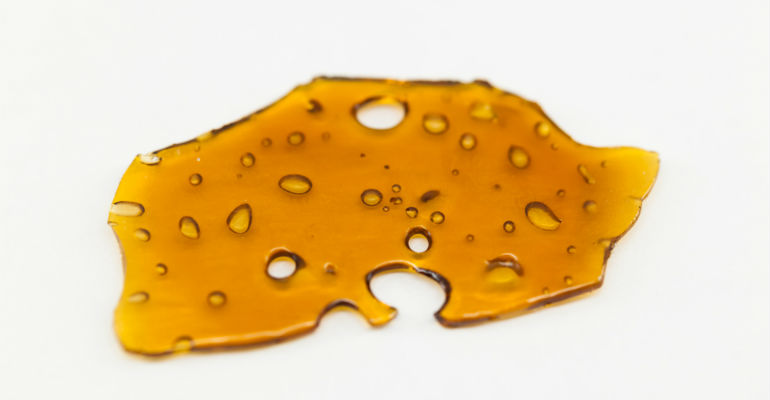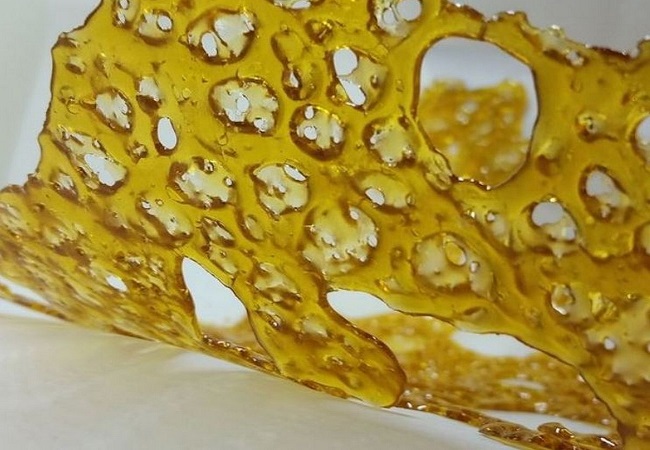Shatter is a cannabis extract that is solid and translucent in appearance, as if you could shatter it like glass. It achieves its glass-like appearance through specific processing techniques involving solvents like butane or other hydrocarbons. Concentrating essential compounds like THC and CBD, shatter offers the benefits of cannabis in a highly concentrated, compact form that is popularly dabbed or vaporized.
“That Tangie shatter I dabbed tastes like pure oranges.”
“I like shatter, but wax is easier to scoop out of the container.”
Shatter is just one form of dabs, the catch-all term for marijuana concentrates produced by extracting cannabinoids like THC and CBD, the plant’s psychoactive chemicals. Other well-known forms include “budder,” which has a creamier, wax-like consistency, and oils, which are golden and honey-like. For all dabs, extraction involves running a solvent — usually butane, carbon dioxide, or propane — through marijuana buds to pull out the cannabinoids, then evaporating the solvent and gathering the resins left behind.
What is shatter?
Shatter is a cannabis concentrate that is named for its hard, glass-like consistency that tends to crack, or shatter, when broken apart. It is typically gold or amber in color. Although shatter is popularly believed to be more potent or pure than other types of extracts, this is not always true; its appearance instead has only to do with the extract’s molecules being less agitated during production.
Shatter is usually dabbed, a method of consumption that involves flash vaporization off of a specialized water pipe called a dab rig. This glassy extract has a reputation for being potent, though it can range in potency depending on the chemical composition of the source plant and the extraction techniques and equipment used. While the high watermark for cannabis flower tends to sit around 30% THC, shatter extracts may test upward of 80% to 90% THC.
How is shatter made?
Shatter can be made using a variety of production methods, but it is typically created using butane or hydrocarbon solvents. Butane extracts are also called BHO, short for “butane hash oil.” To make BHO, cannabis is typically contained in a tube where butane or other hydrocarbons are pushed through the plant material, stripping away desirable compounds like THC and CBD. The concentrated oil is collected and may be further refined using additional techniques. “Purging,” for example, refers to the removal of excess residual solvents using a vacuum chamber, and “winterization” refers to the separation of fats and lipids from the oil.
Shatter and other types of BHO are extremely dangerous to make using at-home DIY setups due to the flammability of butane fumes. Attempts to make BHO in home environments have resulted in several accidental explosions. Professional-grade shatter is produced using safe closed-loop systems that prevent these fumes from entering the ambient environment.
Smoking shatter is a fairly involved and relatively expensive process that, if you’re serious about it, involves a glass psuedo-bong known as a “rig.” (You can crumble it up into a joint, but that, as The Cannabist put it, is for cavemen.) These devices, which range from $100-200 apiece, have a glass “nail” where you’d usually find a bowl. Users heat the nail to about 575-625 degrees Fahrenheit with a butane torch then use a metal dabber (essentially a heat-proof toothpick) to apply a ball of shatter to the nail. The result is instant vaporization — and a potentially overwhelming high.
Shatter isn’t a problem in states like Colorado and Washington, where it enjoys the same status as legal weed. But law enforcement officials on the East Coast, many of whom are dealing with the drug for the first time, aren’t sure whether to be concerned about its ultra-high potency or shrug it off as just another pot product. (Policing marijuana is a very low priority in cities like Boston and Portland.) While pot advocates insist that nobody’s ever died from smoking too much shatter, they are well aware of its potency — and warn first-timers against biting off more than they can chew.
What Are Concentrates?
Let’s take a quick look at what concentrates are, just in case you aren’t familiar with this term. Basically, concentrates are super potent versions of marijuana flower buds. The trichomes and chemicals that make up the medicinal and psychoactive components of marijuana are stripped from plant matter through a process known as solvent extraction. When the stripping process is complete, all that’s left are the cannabinoids (such as THC, CBD, CBN, etc), flavonoids, and terpenes. This is the concentrate that makes dabbing so great.
What Is Dabbing?
So by now, you might be wondering what dabbing is. This is the process of heating butane hash oil (BHO) or CO2 oil using a special rig, and then inhaling the resultant vapor. While many people think that dabbing is similar to smoking, they’re not really the same thing.

Dabbing is a flash-vaporization method for enjoying pot. During the process, most people add some concentrate to a heated water pipe attachment, then inhale as much vapor as they can handle. This gives you an intensely powerful high. The attachment (nail) is usually metal or glass and is heated up by a butane torch most of the time. People who enjoy dabbing enjoy the clean flavors, properly-refined extracts, and the fact that its vapor and not smoke (which many say is healthier for your lungs). Of all the concentrates, some people say that shatter is the most potent.
Additional filtration is used to get rid of other naturally occurring waxes and fats, and this is how it manages to contain crazy high amounts of its active ingredients. Shatter is one of the purest forms of marijuana extract and has an amber, glass-like transparency, along with some of the highest terpene contents of all concentrated extractions. It produces an intense and lasting high. It’s a lot more potent than marijuana in its traditional form, and it gets users higher faster and has a much more intoxicating and intense effect.
By now the question on your mind is probably, how do you use shatter? There are almost as many methods for consuming cannabis extracts as there are different types available. Vaping, wax, shatter, dabbing, rigs, oil – it may be overwhelming for someone who just wants to try shatter for the first time. Moreover, there is often $100-plus equipment that’s required.
The easiest way for new users to consume shatter is by crumbling it up on top of a bowl of a pipe or even into a joint. While there are several different ways to consume shatter, you will need to keep your wits about you since not every method will be suitable for beginners. We will be going into more detail about smoking shatter a little later in this article.
You might also be wondering, is there a difference between shatter and wax? While the potency of wax and shatter is similar, there are some important physical differences. Here are a few to remember:
- Wax is less stable but easier to handle
- Shatter tends to last longer
- Wax has more surface area which means it degrades faster
- Shatter is more stable but harder to handle
- Difference between wax and shatter is mainly in the temperature and finishing process
Shatter is not agitated or mixed to create a new consistency. It’s a translucent sheet that dries to a toffee-like hardness when the butane evaporates. Wax is opaque and semi-solid, resembling cream or hair wax and is formed when the evaporating mix is agitated. There are several variables that can be manipulated to affect the texture of hash oil. Temperature changes, moisture, and physical agitation can all cause translucent oil to be changed into an opaque wax. This agitation causes the THCA (which is solid) to precipitate from the rest of the oil and turn into crystals.
The History of Shatter Weed
During the mid-2000s, there seemed to be a big shift in the cannabis market. Weed smokers were smoking less and dabbing more. However, it’s thought that cannabis extracts, in some form or another, have been around since as early as the 1940s. It’s the adaptation and revival of the solvent-based extraction practices that we know of today that is somewhat new.

Extracts were thought to be stronger, more convenient, and easier to use discreetly. While shatter is a relatively recent development when it comes to cannabis consumption, its roots can be traced back to the old practice of hashish production. In the late 1990s, the modern cannabis concentrate production was refined, and what is now known as shatter was first produced.
In 1989, an author by the name of D. Gold published the second edition of “Cannabis Alchemy: The Art of Modern Hashmaking,” which gave a full explanation on how to make hash. By the late 1990s, a Canadian marijuana manufacturer called BudderKing first marketed shatter and budder. Their products hit the shelves of dispensaries in 2003 and by 2005, Cannabis Culture magazine had published the techniques for using these products. Then, in the 2010s, shatter emerged as a popular choice in weed consumption with dab rigs set alongside water bongs in many smoke stores.
The term “shatter” derives from the fact that the temperature of the leftover resin is often cooled down into a glass sheet, which is similar to how boiled caramel becomes hard like candy.
It’s also good to note that cannabis concentrates are proving that aromatherapy can be a great therapeutic tool. For example, one of the well-known terpenes called myrcene increases the amounts of THC that can cross the blood-brain barrier. This means that myrcene could also improve the efficacy of other drugs.
Although shatter weed production is still mostly illegal, even in states where medical cannabis has been legalized, the community still seems to be split on whether shatter is good or bad for the medical world and patients in general. Some believe that shatter is superior to marijuana in its ability to reduce pain and help treat other medical conditions, but others think that the impurities leftover from production, along with the bad name that BHO is getting because of its careless at home production efforts (which are leading to fires and explosions), negate any of the positive benefits associated with concentrated doses of THC.

If you are a weed rookie, you have probably heard the term “shatter” before but are wondering what the heck it is! Shatter is a concentrated form of cannabis, meaning it is derived from pure cannabis extracts. This means that it contains up to 90% cannabinoid content, making it a hard-hitting method that is far more potent than flower. In fact, shatter is considered one of the purest forms of concentrate, but its delicate nature can make it hard to work with. In comparison, regular bud only has 5-18% cannabinoid content. I would highly NOT recommend shatter for a beginners.
Shatter is the “glass” form of concentrated THC. THC can come in man forms such as flower, or regular old weed, oil, wax or shatter. It is called shatter because it exists as a kind of “glass”. While it is not real glass it is semitransparent and looks similar. Shatter is usually used to dab.